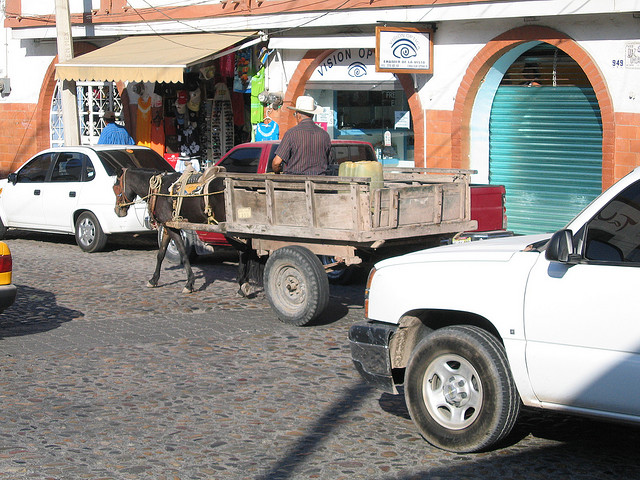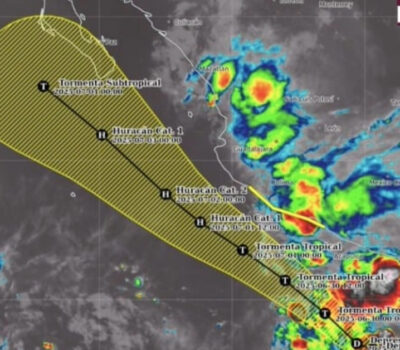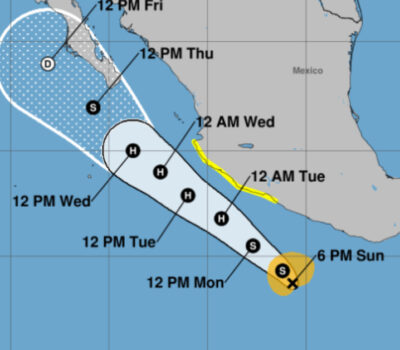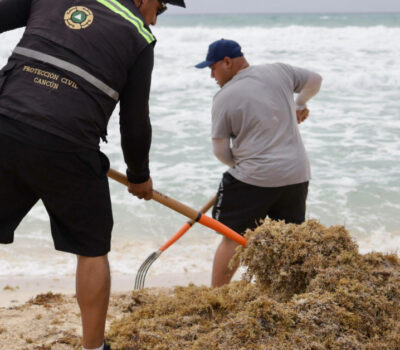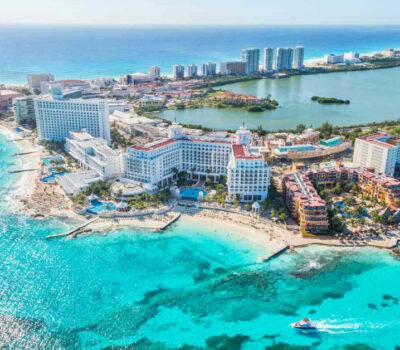In my last article, I shared my experiences commuting on the bus and this week I am continuing my travel theme. Driving daily in a new country is an intense cultural experience that quickly changes you from tourist status to resident as you adapt to a new environment. Although it is generally more convenient to drive than to take city transit, I am glad that I didn’t have to drive the first few months that I was here. I told you in a previous article that I am cautious, and I am not ashamed to say that I was more than a little nervous about driving in a Mexican city. After riding the bus for a few months I became more familiar with the layout of the streets. I then gingerly took the next step and started driving in Puerto Vallarta.
Driving here is a strange mix of “every man for himself” and laid-back cooperation. Not surprisingly, the drivers are generally more aggressive here than in Canada (except for maybe Toronto or Montreal. Sorry guys!) Although, it is not as crazy as I thought it would be, one cannot be complacent behind the wheel. In my experience, most Canadians (including me) drive in a bubble of regulated complacency. That is, we expect the guy driving beside us to drive according to the rules of the road. As such, even though we are taught to be defensive drivers, the bulk of Canadian drivers are not. That is simply not possible here in Mexico. I quickly learned to always expect the unexpected when I get behind the wheel of my truck.
It is well known that intersections are the most likely places to have accidents. With vehicles heading every which way and crossing paths there is bound to be a foul-up now and again. Puerto Vallarta’s streets are no exception, but there are a few stunts that I had not encountered until I moved here. One day I was waiting at a red light on a two lane road. I was the lead vehicle in the left hand lane and a small compact car was in the right hand lane beside me. When the light turned green the guy beside me gunned the engine and turned left in front of me totally cutting off my path! My heart nearly jumped into my throat. I drive a full size pickup truck. Did this guy have a death wish? Not too long afterward I had a similar experience while waiting in the right hand lane at the same intersection. This time, my aggressive neighbour to my left cut me off while turning right. On this occasion, however, I was well aware of my driving surroundings. I gave him a dismissive honk and a, “Come on! What was that?!” wave of my hand. I know what you are all thinking, but it was not a one-finger wave! Some days I don’t even honk any more. Actually, determining if we are going to get cut off by an illegal turn has become a bit of a game for my family while waiting at intersections. We base our predictions on driving style before arriving at the light, relative position of the other vehicle to our own, and our ever accurate “spidey senses” (you know, like Spiderman).
Another thing that took some getting used to, was using lateral lanes in order to turn left. On some of the major multilane roads in the Banderas Bay area, one needs to move into the lateral lanes on the right hand side of the road to make a left turn. At first it felt like my poor Canuck brain had tied itself in a knot. Go to the right hand lanes to turn left? Uh, okay. But now, I willingly go to the right in order to turn left.
I think most of us get that sad sinking feeling when we see a long line of cars waiting to turn left at an intersection. You mutter quietly to yourself and mentally start calculating how many lights you will be waiting. Many drivers in Vallarta battle that yucky feeling by cutting in front of the lead vehicle at the intersection. Several times I have been waiting to turn left only to have someone drive up beside me in the next lane and then pull his/her car in front of me to turn left. Who wants to wait in line? Apparently not the driver who just line jumped! This type of behaviour drives my husband insane (pun intended). It makes him see red almost every single time, especially if the person who just cut in front of us then proceeds to slowly put-put-put through the intersection.
The side streets in Puerto Vallarta add yet another element to driving that I had not encountered in Canada. As I mentioned in my last article, many of the minor streets in Vallarta are either rough cobblestone or dirt roads that can be very narrow. There are speed bumps of all sizes, pot holes, garbage, and often large rocks on the road. As such, drivers tend to weave ALL over the road to try and find the smoothest path for their vehicle. It can be quite disconcerting to be driving along and then have the oncoming car drift into your path. Luckily, the speeds on these roads are usually so slow that most of the time it is not a problem; and all parties manage to get where they are going without crashing into one another. Driving a truck or a sport-utility vehicle is definitely an advantage in these conditions. I honestly don’t know how people who have small cars get around without bashing up the underside of their vehicles.
Without a doubt, motorcycles and mopeds are the most unpredictable component of Mexican driving. Basically, they go anywhere. I’ve seen them on sidewalks, medians, lawns and bike paths. The one law that seems to govern their driving is that of taking the path of least resistance. What this really means is that they will do anything to avoid stopping. I once watched in stunned wonder as a motorcyclist worked his way around a red light. Instead of stopping, he turned right, then immediately bumped over a grassy median, weaved his way between the bumpers of the vehicles stopped at their red light, and pulled into a parking lot on the other side of the intersection. Next he drove through the parking lot and exited on the other side. Tah dah! His audacious driving style made me laugh that day, but often the way that many motorcyclists drive here is just plain dangerous.
Seeing motorcycles deking around vehicles and driving between lanes of cars is pretty much a daily occurrence here, but now and again I still see something that amazes me. Once, I witnessed a woman on the back of a motorcycle applying makeup. In one hand she had the mirror and a mascara tube and in the other hand she held the brush. There was no backrest for her to lean against and she was brushing on mascara! What is more, the driver was turning at an intersection. How she managed to not poke herself in the eye and keep her seat on a moving motorcycle I will never know.
I am also continually amazed at the number of people and items that can be carried on a small motorcycle. It is not uncommon to see three people on a motorcycle that would be considered safe for one or two passengers in Canada. I cringe every time I see a parent riding with two children on a motorcycle without helmets. I understand that for some families this is the only motorized transportation that they can afford, but it still gives me the willies. I can still recall my absolute terror the first time I followed behind a motorcycle with a small baby as a passenger. There was a man driving and a woman riding behind holding on to the driver with her right arm. In her left arm was a small baby. The infant, that looked less than a year old, was propped on her left hip. There they were banging along an uneven, pitted, cobblestone road and all that was keeping her baby safe was her left arm. I wasn’t following close, but I backed off anyway. I’m guessing that the woman probably wasn’t that concerned about it, but I was terrified on her behalf. (This is a service that many Canadians will do for free.)
I should clarify. I am not against motorcycles or kids being on them. My father is an enthusiast and I went with him more than once as a child; however, he took my siblings and I one at a time and we always had a helmet. I don’t think that every Mexican would feel that a baby riding without a helmet on a motorcycle is safe either; but there are clearly some that deem it okay.
This highlights one of the biggest cultural differences between Canada and Mexico: the perception of safety. In general, Mexicans don’t seem to fret about safety, while Canadians, again in general, are all but obsessed by the subject. It is common practice in Mexico to see people riding in the box of a pickup truck, sometimes on top of cargo. I do remember this happening in Canada when I was a child, but it was usually on roads featuring slower speeds. Nowadays, it is pretty much unheard of. In contrast, here in Mexico I’ve seen entire families including grandparents and small children riding in an open box on both low and high speed roads. Sometimes, people will use plastic deck chairs to make the ride more comfortable for some passengers. Often an elderly woman can be found perched on one of these white plastic chairs like a queen with a gaggle of children milling about in the box. As a Canadian, I automatically think about what could occur if the truck happens to swerve or hit a bump, but the Mexican passengers seem oblivious to their potential peril. Usually, they are chatting or hovering over their cell phones.
Although Mexican drivers are more aggressive than Canadian drivers, they can also be very generous on the road. I know that what I have described must sound like a wild driving environment, but courtesy also exists. We all know that waiting to turn left at an intersection without the aid of a traffic light can be onerous. Here in Vallarta, drivers who have the right of way will often slow down or even stop to let another driver turn left. I am not certain why this happens here, but I get a warm fuzzy feeling that all is right with the world when it does. It makes me want to buy the other driver a cup of Tim Horton’s coffee just to reciprocate! (I’m not sure what the American version of this would be. Does Krispy Kreme have good coffee?)
I’m not a particularly aggressive driver. In fact, I have received a couple of honks here in Puerto Vallarta for apparently staying at a stop sign a little too long. So I was surprised to discover that my driving style has changed since moving to Mexico. It has become more “zippy”, which is really a euphemism for more aggressive. I didn’t notice it, however, until I went back to Canada for a visit. I reconnected with some family and friends and cleaned out a storage locker (that is a whole other article). I remember it very clearly. I needed to change lanes, and although my signal was on, the person in the neighbouring lane was not cooperating. You know when the person in the next lane leaves “space” but keeps increasing speed because the driver doesn’t really want to let you in? In the past I would have grumbled about not having enough space, wished a flat tire on the other driver, and waited for another opening. This time, however, I looked and thought, “Oh good there is enough space”, and I zipped into the lane. In my rear-view mirror I saw the other driver slow significantly and then shoot me a dirty look. I didn’t get a one finger wave, but nobody was offering me a Tim Horton’s coffee either. In that moment I realized that my conservative driving style now had a little bit of Mexican spice added to it!
I have gleaned some lessons from my experiences behind the wheel in Mexico. Firstly, keep your head out of the clouds and your mind on the task at hand. You will be a better driver. Secondly, there is a yin and yang balance between being assertive and being passive on the road. Find it, and your blood pressure will thank you! Finally, you can never be too courteous. Letting another driver go first or making a space in your lane are small ways to create good karma. I’ve also learned some great short cuts, but I’m keeping those to myself!
I’ll conclude this article by saying that wherever you are driving in this world, “Let’s be careful out there.” (Those who know this television reference have bragging rights this week. The answer is in the video below.)
The quotation is from Hill Street Blues:
In my last article, I shared my experiences commuting on the bus and this week I am continuing my travel theme. Driving daily in a . . .

